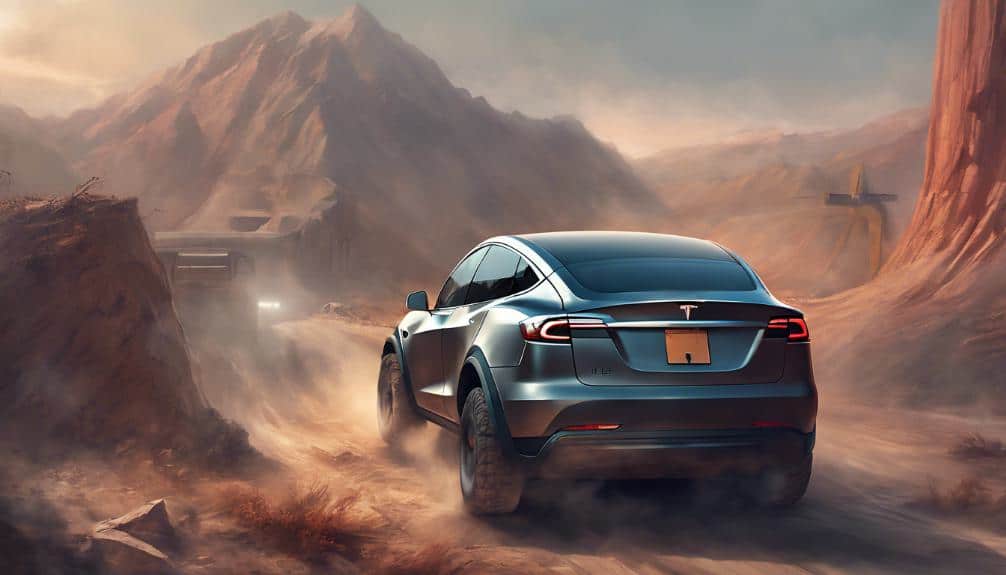Have you ever wondered how the Tesla Model Y manages to balance its ground clearance to excel both on and off the road?
The secrets behind its ideal height aren’t just about numbers but a careful blend of engineering precision and design innovation.
Understanding the intricacies of what lies beneath this electric SUV’s chassis will shed light on its dynamic capabilities and perhaps reveal why it stands out among its competitors.
Key Points
- Weight distribution affects suspension response and ground clearance.
- Suspension setup determines undercarriage-to-ground distance.
- Wheel sizes and tire profiles impact overall ground clearance.
- Adjustable air suspension system allows for changing clearance levels.
- Model Y offers 0.6 inches more clearance than Model 3, enhancing versatility.
Importance of Ground Clearance

Having adequate ground clearance is vital for maximizing your Tesla Model Y’s off-road capability and protecting its undercarriage from potential damage.
The Model Y’s suspension technology plays an important role in providing the necessary ground clearance to tackle various terrain challenges.
The suspension system helps absorb the impact of uneven surfaces, allowing the vehicle to maintain traction and stability.
Without sufficient ground clearance, the undercarriage of your Model Y could be susceptible to damage from rocks, branches, or other obstacles encountered off-road.
When facing terrain challenges such as rocks, mud, or steep inclines, having higher ground clearance is advantageous.
It allows your Model Y to navigate these obstacles with ease, reducing the risk of getting stuck or causing damage to the underside of the vehicle.
Then, the Model Y’s higher ground clearance compared to the Model 3 enhances its ability to handle different driving conditions, making it a versatile option for adventurous journeys.
Proper ground clearance not only enhances off-road performance but also contributes to the overall structural integrity and longevity of your Tesla Model Y.
Factors Affecting Model Y’s Clearance
To understand how various factors influence the clearance of your Tesla Model Y, consider the impact of its weight distribution and suspension setup.
The weight distribution of the vehicle affects how the suspension components respond to the load, potentially altering the ground clearance.
Then, the suspension setup plays an essential role in determining the distance between the vehicle’s undercarriage and the ground.
Tesla has designed the Model Y with specific wheel sizes and tire profiles, which also contribute to its overall ground clearance.
The aerodynamic design of the Model Y, aimed at enhancing efficiency and performance, could impact the clearance as well.
In addition, the Model Y’s adjustable air suspension system provides the flexibility to change ground clearance levels based on driving conditions.
How Does the Ground Clearance of Tesla Model Y Compare to Traditional Lowriders?
The ground clearance of Tesla Model Y significantly surpasses that of traditional lowriders. While lowriders are known for their lowered stance, the Model Y offers a higher ground clearance, making it more practical for various terrains. It’s a fascinating journey through history to see how car designs have evolved to meet different consumer needs.
Comparison With Model 3

The Model Y offers 0.6 inches more ground clearance than the Model 3. This difference in ground clearance between the Model Y and Model 3 impacts their handling and stability on various road surfaces.
The Model Y’s higher ground clearance provides several benefits over the Model 3, especially in off-road driving and rough terrain conditions.
Its enhanced ground clearance gives the Model Y greater versatility and practicality, making it more capable of handling different road conditions effectively.
Also, the increased ground clearance of the Model Y contributes to a more commanding presence on the road compared to the Model 3.
When comparing the Model Y vs. Model 3, the ground clearance benefits of the Model Y become apparent, offering advantages for those who seek a vehicle with improved capability and adaptability to different driving environments.
Off-Road Performance Expectations
Expect the Tesla Model Y to handle light off-road conditions efficiently with its ground clearance and all-wheel drive capabilities.
While not geared for extreme off-roading, the Model Y’s estimated 6.6 inches of ground clearance should suffice for most urban and light off-road driving scenarios.
Its all-wheel drive system, coupled with electric motors, provides solid traction and control on various terrains.
The suspension and design of the Model Y are likely to offer a comfortable and capable ride when handling rougher surfaces.
Although Tesla’s primary focus is on-road performance and efficiency, the Model Y should manage occasional off-road excursions with ease.
When considering terrain capability, the Model Y is best suited for light off-road use, making it ideal for casual off-road driving experiences rather than tackling extreme roughness.
Enhancing Versatility and Appeal

Enhancing the Model Y’s versatility and appeal, consider the benefits of its enhanced ground clearance for a more dynamic driving experience.
The Model Y’s higher ground clearance not only allows for better off-road capability but also enhances its handling on rugged terrain.
Compared to the Model 3, the Model Y offers improved versatility for various driving conditions, making it a more appealing option for customers seeking a rugged and adventurous driving experience.
Tesla’s emphasis on optimizing ground clearance in the Model Y contributes greatly to its overall performance and handling capabilities.
As an Amazon Associate we earn from qualifying purchases.










